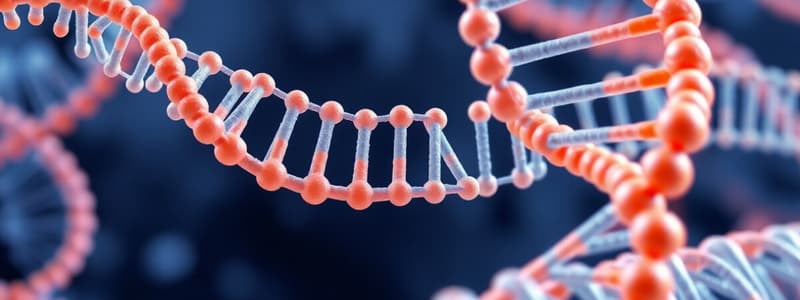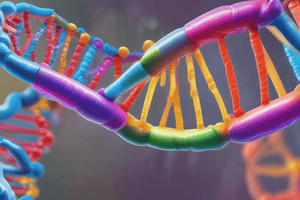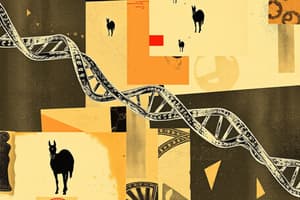Podcast
Questions and Answers
What is a primary role of small nucleolar RNAs (snoRNAs) in pre-rRNA processing?
What is a primary role of small nucleolar RNAs (snoRNAs) in pre-rRNA processing?
- They direct modification enzymes to specific rRNA sites. (correct)
- They provide structural support to the nucleolus.
- They carry out transcription of ribosomal proteins.
- They are involved in the cleavage of pre-rRNA.
Which enzyme is responsible for the transcription of genes encoding ribosomal proteins?
Which enzyme is responsible for the transcription of genes encoding ribosomal proteins?
- DNA polymerase
- RNA polymerase I
- RNA polymerase II (correct)
- RNA polymerase III
What occurs during the assembly of ribosomes?
What occurs during the assembly of ribosomes?
- 5S rRNA is exclusively synthesized in the nucleolus.
- Ribosomal proteins are synthesized in the nucleolus.
- Pre-rRNA associates with ribosomal proteins during its synthesis. (correct)
- Ribosomal proteins first bind to the pre-rRNA after its processing.
What is NOT a modification that occurs during pre-rRNA processing?
What is NOT a modification that occurs during pre-rRNA processing?
Where does the assembly of preribosomal particles primarily occur?
Where does the assembly of preribosomal particles primarily occur?
Which DNA polymerases are responsible for nuclear DNA replication in eukaryotes?
Which DNA polymerases are responsible for nuclear DNA replication in eukaryotes?
What is a fundamental property shared by all DNA polymerases?
What is a fundamental property shared by all DNA polymerases?
What initiates the separation of DNA strands at the origin of replication?
What initiates the separation of DNA strands at the origin of replication?
In prokaryotes, how many origins of replication are typically present?
In prokaryotes, how many origins of replication are typically present?
How do eukaryotes differ from prokaryotes in terms of origins of replication?
How do eukaryotes differ from prokaryotes in terms of origins of replication?
What effect would it have on replication time if a mammalian genome replicated from a single origin?
What effect would it have on replication time if a mammalian genome replicated from a single origin?
Which protein complex is involved in the molecular mechanism of DNA replication?
Which protein complex is involved in the molecular mechanism of DNA replication?
What role does helicase play at the origin of replication?
What role does helicase play at the origin of replication?
Which type of RNA polymerase is responsible for transcribing the 5S rRNA?
Which type of RNA polymerase is responsible for transcribing the 5S rRNA?
How many copies of the gene encoding the 5.8S, 18S, and 28S rRNAs are typically found in the human genome?
How many copies of the gene encoding the 5.8S, 18S, and 28S rRNAs are typically found in the human genome?
Where are the genes encoding the 5S rRNA located in the human genome?
Where are the genes encoding the 5S rRNA located in the human genome?
Which components of the nucleolus reflect the progression of rRNA transcription and processing?
Which components of the nucleolus reflect the progression of rRNA transcription and processing?
What factor primarily influences the size of the nucleolus?
What factor primarily influences the size of the nucleolus?
What is the significance of the 45S pre-rRNA in the cell?
What is the significance of the 45S pre-rRNA in the cell?
What characteristic of rRNA transcription contributes to the high density of RNA chains?
What characteristic of rRNA transcription contributes to the high density of RNA chains?
Which of the following regions in the nucleolus is primarily involved in assembling ribosomal subunits?
Which of the following regions in the nucleolus is primarily involved in assembling ribosomal subunits?
What is the primary function of the RNA-induced silencing complex (RISC) directed by miRNA?
What is the primary function of the RNA-induced silencing complex (RISC) directed by miRNA?
How many different mRNAs can a single miRNA potentially target?
How many different mRNAs can a single miRNA potentially target?
Which type of non-coding RNA is over 200 nucleotides long and plays a role in gene expression regulation?
Which type of non-coding RNA is over 200 nucleotides long and plays a role in gene expression regulation?
What is the function of the nuclear pore complexes in the nuclear envelope?
What is the function of the nuclear pore complexes in the nuclear envelope?
What is a characteristic feature of satellite DNA?
What is a characteristic feature of satellite DNA?
Which part of the nuclear envelope maintains the internal composition of the nucleus?
Which part of the nuclear envelope maintains the internal composition of the nucleus?
What distinguishes AT-rich sequences from GC-rich sequences in the context of DNA density?
What distinguishes AT-rich sequences from GC-rich sequences in the context of DNA density?
What is the primary role of the nuclear envelope in eukaryotic cells?
What is the primary role of the nuclear envelope in eukaryotic cells?
What effect do deletions that affect residues 126 to 132 have on the T antigen?
What effect do deletions that affect residues 126 to 132 have on the T antigen?
What is a characteristic feature of nuclear localization signals (NLS)?
What is a characteristic feature of nuclear localization signals (NLS)?
Which proteins are primarily involved in the transport of proteins to the nucleus?
Which proteins are primarily involved in the transport of proteins to the nucleus?
What happens to the importin-Ran/GTP complex in the nucleus?
What happens to the importin-Ran/GTP complex in the nucleus?
What is the role of Ran-GAP in nuclear transport?
What is the role of Ran-GAP in nuclear transport?
What type of sequence does nucleoplasmin have for its nuclear localization signal?
What type of sequence does nucleoplasmin have for its nuclear localization signal?
How do importins transport cargo proteins through the nuclear pore complex?
How do importins transport cargo proteins through the nuclear pore complex?
What determines the directionality of nuclear transport?
What determines the directionality of nuclear transport?
What role do helicases play in DNA replication?
What role do helicases play in DNA replication?
How do topoisomerases alleviate stress during DNA replication?
How do topoisomerases alleviate stress during DNA replication?
What importance does the accuracy of DNA replication hold?
What importance does the accuracy of DNA replication hold?
What unique activity do exonucleases of polymerase III and polymerase δ and ε provide?
What unique activity do exonucleases of polymerase III and polymerase δ and ε provide?
What is the function of single-stranded DNA-binding proteins during replication?
What is the function of single-stranded DNA-binding proteins during replication?
How does telomerase differ from other DNA polymerases?
How does telomerase differ from other DNA polymerases?
What mechanism allows DNA polymerase to ensure high fidelity during replication?
What mechanism allows DNA polymerase to ensure high fidelity during replication?
What is the role of DNA polymerase in relation to RNA primers?
What is the role of DNA polymerase in relation to RNA primers?
Flashcards
Helicases
Helicases
Enzymes that unwind the double helix of DNA during replication, separating the two strands. They use the energy from ATP hydrolysis to break the hydrogen bonds between the bases.
Single-stranded DNA-binding proteins
Single-stranded DNA-binding proteins
Proteins that bind to single-stranded DNA, preventing it from re-annealing and keeping it available for replication.
Topoisomerases
Topoisomerases
Enzymes that relieve the torsional stress caused by DNA unwinding during replication. They cut and re-ligate DNA strands to allow for rotation.
DNA Replication
DNA Replication
Signup and view all the flashcards
Telomerase
Telomerase
Signup and view all the flashcards
Fidelity of DNA Replication
Fidelity of DNA Replication
Signup and view all the flashcards
Exonuclease Activity
Exonuclease Activity
Signup and view all the flashcards
Double Reading Activity
Double Reading Activity
Signup and view all the flashcards
miRNA (microRNA)
miRNA (microRNA)
Signup and view all the flashcards
lncRNA (Long non-coding RNA)
lncRNA (Long non-coding RNA)
Signup and view all the flashcards
Nuclear Envelope
Nuclear Envelope
Signup and view all the flashcards
Nuclear Pore Complex
Nuclear Pore Complex
Signup and view all the flashcards
Nuclear Lamina
Nuclear Lamina
Signup and view all the flashcards
Repetitive DNA Sequences
Repetitive DNA Sequences
Signup and view all the flashcards
Single Sequence Repeats
Single Sequence Repeats
Signup and view all the flashcards
Satellite DNA
Satellite DNA
Signup and view all the flashcards
DNA polymerase properties
DNA polymerase properties
Signup and view all the flashcards
Origin of replication
Origin of replication
Signup and view all the flashcards
Initiator proteins
Initiator proteins
Signup and view all the flashcards
Replisome
Replisome
Signup and view all the flashcards
Prokaryotic replication
Prokaryotic replication
Signup and view all the flashcards
Eukaryotic replication
Eukaryotic replication
Signup and view all the flashcards
Nuclear Localization Signal (NLS)
Nuclear Localization Signal (NLS)
Signup and view all the flashcards
Importin
Importin
Signup and view all the flashcards
Ran
Ran
Signup and view all the flashcards
Nuclear Pore Complex (NPC)
Nuclear Pore Complex (NPC)
Signup and view all the flashcards
Nuclear Import
Nuclear Import
Signup and view all the flashcards
Nuclear Export
Nuclear Export
Signup and view all the flashcards
Ran-GAP
Ran-GAP
Signup and view all the flashcards
Ran Cycle
Ran Cycle
Signup and view all the flashcards
What are two important modifications in pre-rRNA processing?
What are two important modifications in pre-rRNA processing?
Signup and view all the flashcards
What is the role of snoRNPs in pre-rRNA processing?
What is the role of snoRNPs in pre-rRNA processing?
Signup and view all the flashcards
How are ribosomes assembled?
How are ribosomes assembled?
Signup and view all the flashcards
How are ribosomal proteins involved in ribosome assembly?
How are ribosomal proteins involved in ribosome assembly?
Signup and view all the flashcards
What is the role of 5S rRNA in ribosome assembly?
What is the role of 5S rRNA in ribosome assembly?
Signup and view all the flashcards
rRNA Transcription
rRNA Transcription
Signup and view all the flashcards
45S pre-rRNA
45S pre-rRNA
Signup and view all the flashcards
Nucleolus
Nucleolus
Signup and view all the flashcards
Nucleolar Organization Regions (NORs)
Nucleolar Organization Regions (NORs)
Signup and view all the flashcards
RNA Polymerase I (RNApolI)
RNA Polymerase I (RNApolI)
Signup and view all the flashcards
rRNA Processing
rRNA Processing
Signup and view all the flashcards
Dense Fibrillar Component (DFC)
Dense Fibrillar Component (DFC)
Signup and view all the flashcards
Granular Component (G)
Granular Component (G)
Signup and view all the flashcards
Study Notes
Unit 3: The Nucleus
- The nucleus acts as a storehouse for genetic information, with DNA replication and RNA transcription and processing occurring within it.
- It regulates gene expression by controlling the transport of transcription factors from the cytoplasm to the nucleus.
3.1 The Cell Nucleus and DNA
- Prokaryotes lack a nucleus, but eukaryotes have a nucleus that contains DNA.
- DNA's primary function is storing genetic information.
- DNA replication (creating identical copies) occurs at the genomic level within the nucleus.
- RNA transcription and processing are also vital nuclear processes, creating RNA molecules from DNA templates.
- Gene expression regulation involves controlling the movement of transcription factors from cytoplasm to the nucleus.
Chromosomes and Chromatin
- Eukaryotic genomes are complex, organized on multiple linear chromosomes.
- DNA associates with proteins (histones), compacting it for fit within the cell nucleus. Human DNA unravels to 2 meters but has to fit in a 5-10µm area.
- Chromosomes exist in two forms: highly condensed chromosomes (present during cell division) and uncondensed chromatin (found during interphase).
- Heterochromatin and euchromatin are two major chromatin classes; heterochromatin is condensed and inactive, while euchromatin is less condensed and active in transcription. Chromatin at interphase is observed to be uncondensed throughout the nucleus while highly condensed regions are less prevalent.
Levels of DNA Packaging
- DNA exists in several levels of packaging, ranging from short 2nm regions of the DNA “beads on a string” to the coil condensed structures of 30nm chromatin fibres (interphase) to 300nm - 700nm structures.
- Ultimately DNA is tightly wound into 1,400 nanometer chromatids.
3.2 Nuclear Envelope
- The nuclear envelope separates the nucleus from the cytoplasm.
- It is a double membrane with an outer and inner membrane, with the outer membrane continuous with the endoplasmic reticulum.
- The nuclear lamina provides structural support to the nucleus.
- Nuclear pore complexes act as channels for regulating the passage of proteins, RNA's, and other molecules into and out of the nucleus.
3.3 DNA Replication
- DNA replication is a semi-conservative process where each new DNA molecule has one original strand and one newly synthesized strand.
- DNA polymerase synthesizes DNA only in the 5' to 3' direction, adding to the 3′ OH- end of a growing strand.
- Replication begins at replication origins recognized by initiator proteins, proceeding outward in both directions. Replicated segments may be hundreds of kb.
- Eukaryotes have multiple origins to facilitate rapid genome replication.
DNA Maintenance
- DNA replication is highly accurate, with error frequencies less than one incorrect base for every 10^8 bases.
- Mechanisms like proofreading (exonuclease activity of polymerases) and base selection by polymerases contribute to this accuracy. Mechanisms that aid in correcting an incorrect base are 3′ to 5′ exonuclease activity.
3.4 DNA Transcription
- DNA strands have different functions in transcription. The synthesis of RNA is carried out by RNA polymerase using the antisense strand as a template.
- RNAP II synthesizes mRNA, which is pivotal in gene expression and protein synthesis.
- Transcription is a multi-step process involving initiation, elongation, and termination. Initiation requires RNA polymerase binding to the promoter and unwinding DNA. During elongation, RNAP synthesizes RNA. Termination signals stop the process.
- Eukaryotic cells contain three distinct polymerases with different targets and mechanisms.
3.5 Traffic Between Nucleus and Cytoplasm
- Selective transport of proteins and RNAs across the nuclear membrane.
- Some proteins enter the nucleus because they have a nuclear localization signal (NLS).
- Proteins are tagged with a nuclear export signal (NES) to leave the nucleus.
- Specialized proteins like importins and exportins, along with Ran proteins (GTP), facilitate the selective transport.
3.6 Nuclear Bodies
- Specialized subnuclear compartments with diverse functions in RNA processing, DNA repair, and gene regulation.
- Vary in number per nucleus; function frequently not fully understood. Examples include the nucleolus, Cajal bodies, nucleolar associated speckles and PML-bodies, which may play a role in gene expression and DNA repair.
Genes and Genomes
- Genome; the complete set of genetic instructions of an organism.
- Gene: a DNA sequence that encodes a specific protein or RNA molecule.
Studying That Suits You
Use AI to generate personalized quizzes and flashcards to suit your learning preferences.




